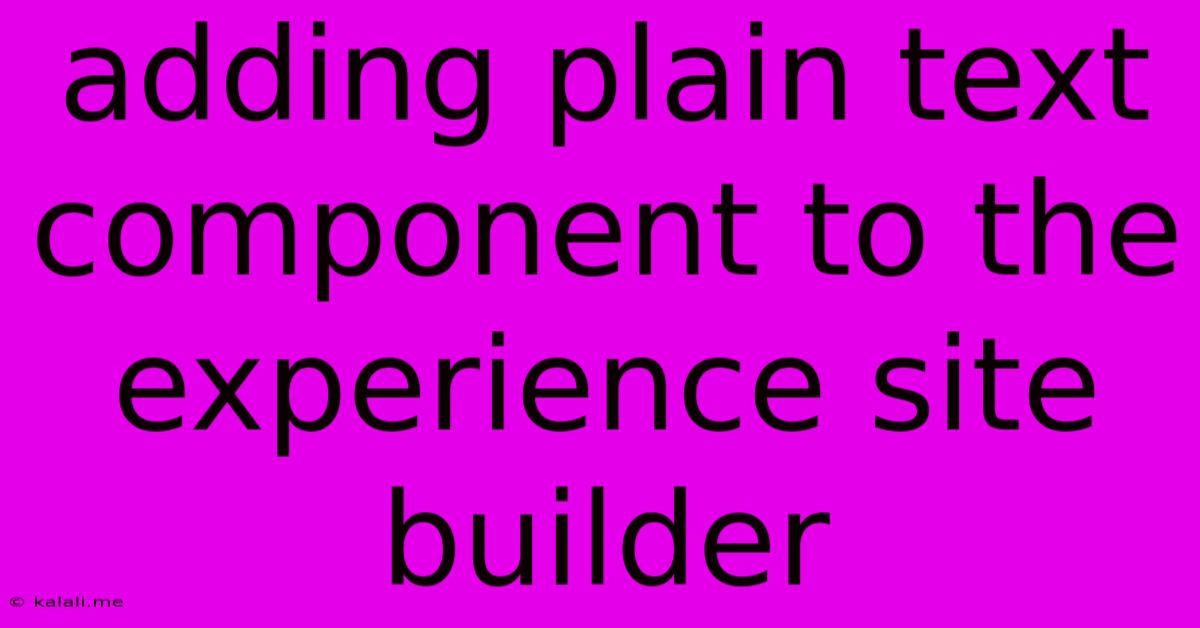Adding Plain Text Component To The Experience Site Builder
Kalali
May 25, 2025 · 3 min read

Table of Contents
Adding Plain Text Components to Your Experience Site Builder: A Comprehensive Guide
Meta Description: Learn how to seamlessly integrate plain text components into your experience site builder, enhancing user experience and improving SEO. This guide covers best practices for formatting, styling, and optimizing text for optimal performance.
Building a compelling experience site hinges on more than just stunning visuals; it requires a robust text component to convey your message effectively. A well-implemented plain text component allows for flexibility and control, crucial for crafting engaging and informative content. This guide details how to add and optimize plain text components within your experience site builder, focusing on user experience and SEO best practices.
Understanding the Importance of Plain Text Components
Plain text components might seem basic, but they're foundational to any successful website. They provide the core content, conveying information, engaging users, and influencing search engine rankings. Without a robust and customizable plain text component, your site builder is severely limited. The ability to easily add, format, and style text is paramount for creating a user-friendly and SEO-friendly website. Key benefits include:
- Enhanced User Experience: Well-formatted text is easier to read and understand, leading to a more positive user experience.
- Improved SEO: Properly structured and keyword-rich text significantly improves search engine visibility.
- Content Flexibility: Plain text allows you to adapt to various content needs, from short descriptions to lengthy articles.
- Branding Consistency: Consistent text formatting ensures a unified brand identity across your website.
Steps to Adding Plain Text Components
The specific steps for adding a plain text component will vary slightly depending on your site builder. However, the general process usually involves these steps:
-
Accessing the Text Component: Locate the text component within your site builder's interface. This is typically represented by an icon (often resembling a "T" or a paragraph symbol).
-
Adding the Component to the Page: Drag and drop the text component onto the desired location on your webpage.
-
Entering Your Text: Begin typing your content directly into the text editor provided.
-
Formatting Your Text: Utilize the formatting options available within the text editor. These usually include options for:
- Headers (H1-H6): Use headers to structure your content logically and improve readability. Remember to use H1 for the main title only.
- Bold (bold text): Emphasize key words or phrases.
- Italics (italic text): Highlight specific terms or add stylistic variation.
- Lists (bulleted and numbered): Organize information clearly.
- Links: Add links to internal pages or external resources.
-
Styling Your Text: Most site builders allow you to customize the appearance of your text. This may include options for:
- Font Selection: Choose a font that's both legible and consistent with your brand.
- Font Size: Adjust the font size to ensure optimal readability.
- Color: Select a text color that contrasts effectively with the background.
- Alignment: Align text to the left, center, or right, depending on your design preferences.
SEO Optimization for Plain Text Components
Integrating SEO best practices into your text component is crucial for higher search engine rankings. Consider these strategies:
- Keyword Research: Identify relevant keywords related to your content and incorporate them naturally throughout your text.
- Meta Descriptions: Write concise and compelling meta descriptions for each page to entice users to click through from search results.
- Header Optimization: Use headers (H1-H6) to structure your content and include relevant keywords in your headers.
- Image Optimization: If using images, ensure they are optimized with descriptive alt text.
Best Practices for a Seamless User Experience
Beyond technical implementation, focus on creating a positive user experience:
- Readability: Prioritize clear, concise writing. Use short sentences and paragraphs to improve readability.
- Whitespace: Utilize whitespace effectively to avoid overwhelming users with dense text.
- Visual Hierarchy: Use headings, subheadings, bold text, and lists to create a visual hierarchy that guides users through your content.
- Mobile Responsiveness: Ensure your text is responsive and displays correctly across various devices.
By carefully considering these aspects, you can leverage plain text components to enhance both the user experience and the SEO performance of your experience site. Remember, even a simple text component, when implemented thoughtfully, can significantly contribute to a successful online presence.
Latest Posts
Latest Posts
-
Din Tai Fung Green Bean Recipe
May 25, 2025
-
Where To Watch Boku No Pico
May 25, 2025
-
How To Remove Ink From Paper
May 25, 2025
-
After A Colon Do You Capitalize
May 25, 2025
-
How Long Are Beans Good For In The Fridge
May 25, 2025
Related Post
Thank you for visiting our website which covers about Adding Plain Text Component To The Experience Site Builder . We hope the information provided has been useful to you. Feel free to contact us if you have any questions or need further assistance. See you next time and don't miss to bookmark.